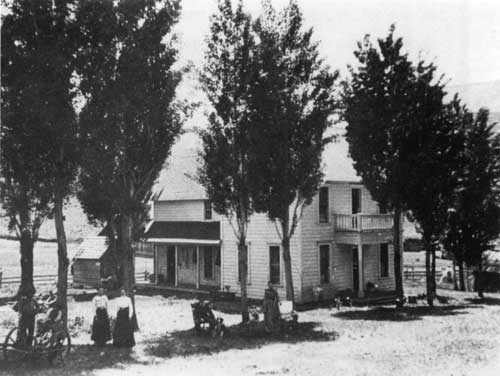Isolation was a common feature for the scattered residents in the far reaches of the PNW. Until the 1910s, most of the region was linked to the outside world only by a system of trails and rudimentary wagon roads. Lack of electricity and telephone lines perpetuated isolation far longer than in other areas.
Residents used candles, kerosene lamps, carbide lamps, and their own electrical plants. Larger ranches such as that of James and Elizabeth Cant by the 1910s had their own generators to provide a few hours of electricity each day to run shearing equipment, operate electric lights or, by the 1920s, to power a radio. “Yeah, we spent lonely days,” recalled Rhys Humphreys, “but we didn’t know any better. It was lonely here; the only people that we ever visited was neighbors” (Cant Ranch Oral History, Royal Jackson, OSU). Isolation for some was a function of labor. The dozens of men who tended sheep and prospectors and miners frequently lived alone or far from society for days and weeks.

Daily labors in an era of subsistence living were often gender specific. Women customarily carried nearly total responsibility for maintaining the household and child-rearing. Their tasks — backbreaking and monotonous — involved cooking, washing, mending, making clothing, food preservation, and cleaning.
They planted and weeded vegetable gardens, drove away birds and rabbits, picked foodstuffs, dried and parched foods, canned dozens of pints and quarts of home-grown fruit and vegetables, and recycled materials. Their fingers turned old clothing into quilts and rag rugs. They watered stove ashes in hoppers to make lye to process fat and bacon grease into soap. They raised chickens and collected eggs and milked cows and made butter. Any surpluses they carried to town to barter for dry goods and staples. They worked constantly and lived frugally.

Men shouldered other responsibilities. They cut, hauled, and stacked wood to fire cook stoves and heat dwellings. In winter they sawed blocks of ice and hauled them to insulated ice houses for use in subsequent months for food preservation and for cooling beverages. They dug cellars, lined them with stone, and filled bins with potatoes, turnips, and apples wrapped in newspapers.
Hard labor duties for men included stock tending, sheep shearing, branding, fence construction and maintenance, building houses and barns, blacksmithing, moving herds to markets, and digging ditches. Irrigation was critical in an arid environment. Men hand-dug canals and ditches, planted willows, locust, and poplar along their courses to stabilize their banks, and worked each year to clean the ditches of slide debris and weeds and to repair washouts.
Men repaired wagons, harness, mowing machines, plows, harrows, and tools. They hauled foodstuffs in wagons, on pack teams, in touring cars, and in trucks. They changed oil and gaskets, repaired flat tires, and rebuilt engines.

Men also contributed to the family diet by hunting, fishing, planting, and pruning fruit trees as well as butchering cattle, sheep, and hogs. They constructed smokehouses and tended fires to preserve meat as jerky and hams. Some worked with their wives to stuff intestines with ground meat fragments and spices to make sausage or head cheese.
They hauled wheat to grist mills and brought home flour and corn meal. They tilled the vegetable patch and helped guard the plantings from hungry deer and rabbits. They tanned hides and bartered with Indians for gloves and moccasins. When they lacked cash, a common occurrence, they bartered labor, goods. and livestock for necessary commodities, tools, or food.

Alongside their parents were the children, ever present in all aspects of the work that needed to be done, helping out where they could, and given more responsibilities as they grew older. But the children’s stories will have to wait for another time….
Excerpts from Rocks & Hard Places: Historic Resources Study of the John Day Fossil Beds – NPS, based upon Cant Ranch Oral History, Royal Jackson, OSU
Title photograph – Ranch house of the Henry Wheeler family, on SR 207 between Service Creek and Mitchell, one mile south of Twickenham Junction, ca 1910 (Courtesy Fossil Museum)


